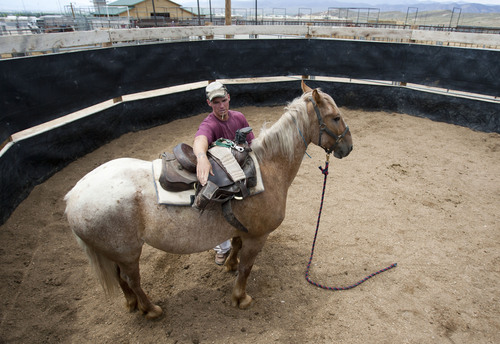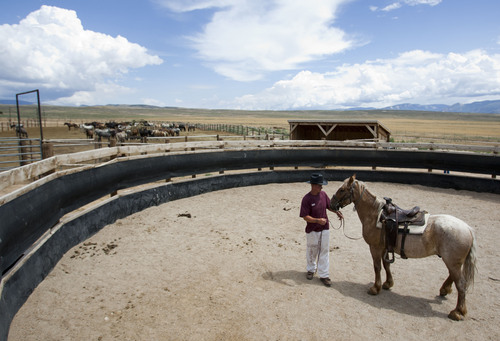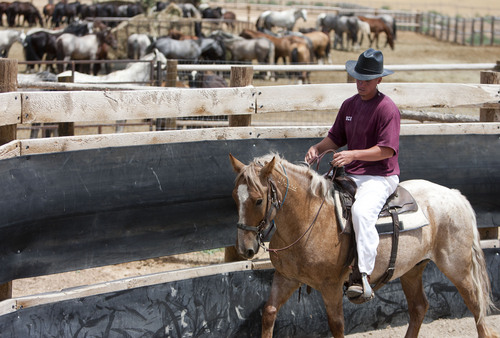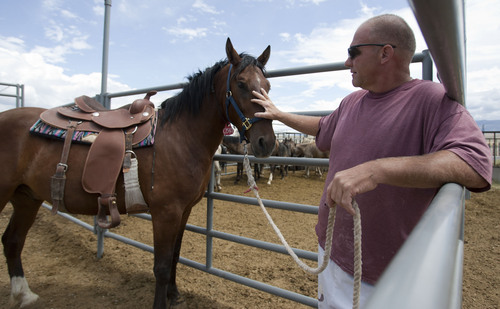This is an archived article that was published on sltrib.com in 2014, and information in the article may be outdated. It is provided only for personal research purposes and may not be reprinted.
The U.S. Bureau of Land Management has 30 days to move more than 1,100 wild horses out of state after the Utah Department of Corrections terminated its Wild Horse & Burro Program, ending a seven-year partnership with the federal agency.
Corrections officials said the program was burning a hole in their budget, that what was meant to be self-sustaining had become a financially unfeasible enterprise.
But BLM insisted Friday that not only had it done its part to support the program at the Gunnison prison in central Utah, but an audit last year revealed the federal government had overpaid Utah by about $2 million since the program's introduction in April 2007.
Hanging in the balance of this disagreement are 1,126 horses and 11 to 17 inmates who care for the wild mustangs kept on a 40-acre parcel of prison land.
BLM has until Oct. 6 to remove the horses. The agency hasn't yet determined where they'll go — areas in Arizona, California and Nevada are being considered to house a majority of the mustangs.
About 50 will stay behind in Axtell, Utah, though the state has nearly 4,000 wild horses — more than double the number the BLM has designated as Utah's upper limit.
Iron and Beaver county commissioners and ranchers in the Blawn Wash area whose livestock compete for forage have been pushing BLM to bring wild horse numbers down.
But the agency was reluctant to do roundups of wild horses in the West this year due to a low demand for horse adoptions. Nearly 50,000 horses are already being kept in holding pastures in the Midwest.
In late July, BLM removed 143 horses from Beaver County's Wah Wah Mountains, and during the roundup, a yearling filly and 7-year-old mare died.
Tom Gorey, public information officer for the BLM, declined to get into specifics about where the more than 1,100 horses currently corralled at Gunnison would be going or how they would be moved.
Although ballooning numbers of wild horses are stretching BLM resources to their limits, the sites the agency is considering are all "near capacity" but not full.
According to an audit conducted by U.S. Office of Inspector General, $2,004,553 in funding from the BLM to the state's Department of Corrections were found to be either questionable or unsupported — meaning Utah failed to adequately document or justify how such monies were used.
Auditors, who completed their investigation a year ago, noted that the financing structure of the Wild Horse & Burro program had changed over time: Initially, BLM reimbursed Utah for each horse held at the Gunnison facility at a rate of $2.75 per head per day. That amount rose over time, with the most recent rate being $3.55.
After the government learned of the $2 million that is allegedly unaccounted for — in contractual services, equipment rental costs, building and ground fees and depreciation — the agency restructured its financial agreement with Utah into a reimbursement-based system.
That means that for every dollar Utah spent on the program, the state was tasked with documenting its purchases and the BLM would reimburse them accordingly.
Mike Haddon, the deputy director of administrative services for the Utah Department of Corrections, said the bureau refused to reimburse them for certain purchases and declined requests necessary to the program's survival.
"As a state agency that depends on tax dollars, we cannot operate programs at a loss," Corrections Director Rollin Cook said in the Friday statement. "We are disappointed that the challenges could not be overcome. We plan to invest our efforts in expanding other existing evidence-based programs and setting up new programs that prepare an even greater number of inmates to re-enter society with relevant, more employable skills."
The two agencies will continue to work together to settle any outstanding debts or monies owed between them, officials said.
"This program was never intended to be a money-maker for any party," Gorey said. "The benefit to Utah is they get a rehab and job-training program in place for their inmates. ... It's a shame the program is being shut down over a disagreement over the expenses covered and billed."
It was not yet known what new programs might replace the Wild Horse & Burro Program or how the Gunnison prison would repurpose its 40-acre facilities.
The Wild Horse & Burro Program has been operational at the Gunnison prison since April 2007. Three supervising officers and a rotating crew of 11 to 17 inmates cared for the wild mustangs kept there. The BLM also had one person assigned to the program.
Through that program, as well as an Internet-based adoption program, approximately 34 horses were adopted each year on average from the Gunnison facility.
Gorey said the BLM works with several states to run similar programs at correctional facilities around the country.
"I think anyone who has observed this up close and personal sees the benefit," Gorey said. "You have inmates learn a lot of patience — training horse is not easy — and really seem to bond with the horse, they learn how to take care of something outside of themselves."
BLM officials said they will hire a non-governmental agency to conduct another audit of their finances and arrangement with Utah's corrections system.
The American Wild Horse Preservation Campaign called for an "across-the-board hold" on BLM's horse program after news of its financial disagreement with Utah broke. In a news release, the group alleges widespread "corruption, mismanagement and incompetence."
Utah corrections officials said they would "work with BLM" should the agency be unable to move all 1,100 horses by its Oct. 6 deadline.
Twitter: @Marissa_Jae











